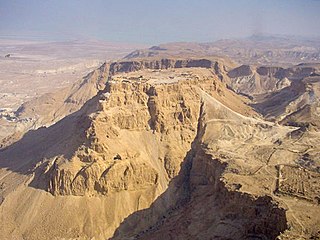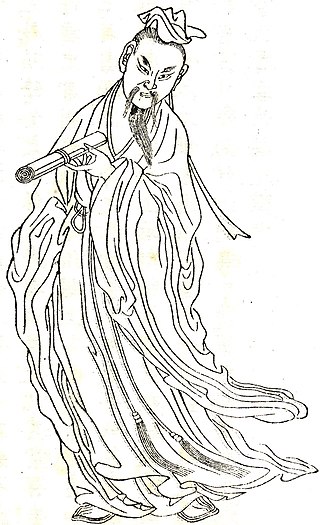Related Research Articles

AD 73 (LXXIII) was a common year starting on Friday of the Julian calendar. At the time, it was known as the Year of the Consulship of Domitian and Messalinus. The denomination AD 73 for this year has been used since the early medieval period, when the Anno Domini calendar era became the prevalent method in Europe for naming years.
Dou Xian was a Chinese general and consort kin of the Eastern Han dynasty, famous for destroying the Xiongnu nomadic empire.

Emperor Ming of Han, born Liu Yang and also known as Liu Zhuang and as Han Mingdi, was the second emperor of China's Eastern Han dynasty.

Ban Gu was a Chinese historian, poet, and politician best known for his part in compiling the Book of Han, the second of China's 24 dynastic histories. He also wrote a number of fu, a major literary form, part prose and part poetry, which is particularly associated with the Han era. A number of Ban's fu were collected by Xiao Tong in the Wen Xuan.

The Hexi Corridor (Chinese: 河西走廊; pinyin: Héxī Zǒuláng; Wade–Giles: Ho2-hsi1 Tsou3-lang2, Xiao'erjing: حْسِ ظِوْلاْ, IPA: ), also known as the Gansu Corridor, is an important historical region located in the modern western Gansu province of China. It refers to a narrow stretch of traversable and relatively arable plain west of the Yellow River's Ordos Loop, flanked between the much more elevated and inhospitable terrains of the Mongolian and Tibetan Plateaus. The name Hexi, refers to "west of the river".

Yarkant County, also Shache County, also transliterated from Uyghur as Yakan County, is a county in the Xinjiang Uyghur Autonomous Region, China, located on the southern rim of the Taklamakan Desert in the Tarim Basin. It is one of 11 counties administered under Kashgar Prefecture. The county, usually referred to as Yarkand in English, was the seat of an ancient Buddhist kingdom on the southern branch of the Silk Road and the Yarkand Khanate. The county sits at an altitude of 1,189 metres (3,901 ft) and as of 2003 had a population of 373,492.

Ban Chao, courtesy name Zhongsheng, was a Chinese diplomat, explorer, and military general of the Eastern Han Dynasty. He was born in Fufeng, now Xianyang, Shaanxi. Three of his family members—father Ban Biao, elder brother Ban Gu, younger sister Ban Zhao—were well known historians who wrote the historical text Book of Han, which recorded the history of the Western Han Dynasty. As a Han general and cavalry commander, Ban Chao was in charge of administrating the "Western Regions" while he was in service. He also led Han forces for over 30 years in the war against the Xiongnu and re-established Han control over the Tarim Basin region. He was made Protector General of the Western Regions by the Han government for his efforts in protecting and governing the regions. Ban Chao is depicted in the Wu Shuang Pu by Jin Guliang.
The Battle of Jushi was a battle between the Han Dynasty and the Xiongnu for control of the people of the Jushi culture in the Turpan Basin in 67 BC. The battle was a success for the Han, who were led by Zheng Ji. The king of Jushi Wugui surrendered to the Han after the Han launched the attack from the Tarim Basin and besieged the city Jiaohe, capital of Jushi. The Xiongnu came with aid to Jushi, but escaped after Zheng Ji and Sima Xi confronted the armies. Zheng Ji then left 20 men with a general to protect the king of Jushi, but he was afraid of the return of Xiongnu, and fled to Wusun. The Xiongnu installed Doumo as the king of Jushi, and moved the population further east from Jiaohe. Zheng Ji then sent 300 men to seize the city.
The Battle of Loulan (樓蘭之戰) in 108 BC marks the earliest Chinese military venture into Central Asia, after a conflict of the Han Dynasty with Loulan and Jushi and a switch of allegiance to the Xiongnu. The Han launched an attack by first arresting the king of Loulan, and turned on the offense against Jushi. The battle resulted in the submission of both Wusun and Dayuan, and an increased role, reputation, and status for imperial Han Chinese politics in Central Asia.
The Battle of Mayi, also known as the Scheme of Mayi (馬邑之謀) or the Encirclement at Mayi (馬邑之圍), was an abortive ambush operation by the Han dynasty against the invading Xiongnu forces led by Junchen Chanyu, with minimal casualties from both sides. Although no fighting actually took place, it marked the end of de jure peace between the Han dynasty and Xiongnu, and led to the beginning of the subsequent Han-Xiongnu War. The failure of the operation also motivated the Han court to develop effective cavalry forces and the use of offensive expeditionary military policies.
Dou Gu, born in Xianyang, was a Chinese military general during the Eastern Han dynasty who fought in the Battle of Yiwulu in 73. Shortly after the battle, Dou Gu sent two of his generals, Ban Chao and Guo Xun, on a diplomatic expedition to the Western Regions.
Chen Mu was a governor and general during the Han Dynasty who served the first Protector General of the Western Regions under Eastern Han between 74–75. During his service, he was killed by the rebels in Karasahr in A.D. 75, during the Han-Xiongnu War.

The Battle of Altai Mountains, was a major expedition launched against the Northern Xiongnu by the Han dynasty in June AD 89. The battle was a success for the Han under Dou Xian.

The Han–Xiongnu War, also known as the Sino–Xiongnu War, was a series of military conflicts fought over two centuries between the Chinese Han Empire and the nomadic Xiongnu confederation, although extended conflicts can be traced back as early as 200 BC and ahead as late as 188 AD.
Zhao Xin was a prominent Xiongnu general in the late 2nd century BCE during the Han–Xiongnu War. He defected first to the Han Dynasty then back to the Xiongnu.

The Protectorate of the Western Regions (simplified Chinese: 西域都护府; traditional Chinese: 西域都護府; pinyin: Xīyù Dūhù Fǔ; Wade–Giles: Hsi1-yü4 Tu1-hu4 Fu3) was an imperial administration (a protectorate) situated in the Western Regions administered by Han dynasty China and its successors on and off from 59 or 60 BCE until the end of the Sixteen Kingdoms period in 439. The "Western Regions" refers to areas west of Yumen Pass, especially the Tarim Basin in southern Xinjiang. These areas would later be termed Altishahr (southern Xinjiang, excluding Dzungaria) by Turkic-speaking peoples. The term "western regions" was also used by the Chinese more generally to refer to Central Asia.
The Chief Official of the Western Regions was a Chinese military official in charge of the Western Regions during the Eastern Han, Cao Wei and Jin dynasties.
Ban Yong, courtesy name Yiliao (宜僚), was the youngest son of the famous Chinese General, Ban Chao, and the nephew of the illustrious historian, Ban Gu, who compiled the Book of Han, the dynastic history of the Former Han dynasty.
The history of Kashgar begins in the first millennium BC, when the tribes of Yuedzhi, Usuns and Saks were roaming around the vast expanses of the Taklamakan Desert and the piedmont slopes of the Pamir. Wandering from one encampment to another in the oases, they eventually began founding small settlements, which later were developed into cities on the Silk Road.

The military of the Han dynasty was the military apparatus of China from 202 BC to 220 AD, with a brief interregnum by the reign of Wang Mang and his Xin dynasty from 9 AD to 23 AD, followed by two years of civil war before the refounding of the Han.
References
- ↑ Graff 2002, p. 40.